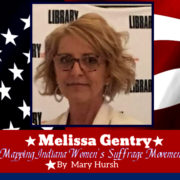Mapping Indiana Women’s Suffrage Movement
By Mary Hursh
The women’s suffrage movement spanned decades. In 1911, the Woman’s Franchise League of Indiana was formed and became the propelling force for the right to vote. Women from all walks of life participated in the many marches, campaigns, and demonstrations that finally resulted in the passage of the l9th Amendment granting women the right to vote.
Chautauqua-Wawasee, in partnership with the Syracuse-Wawasee Historical Museum, the Syracuse Public Library, the Syracuse-Wawasee Chamber and Indiana Humanities, has a number of events and expert speakers planned for Syracuse to highlight and educate about right-to-vote movement.
On August 26, from 6:30-7:30 p.m., the Oakwood Resort will host the first speaker in the women’s suffrage centennial celebration. It is free to attend.
Melissa Gentry, from Ball State University, will map the Indiana women’s suffrage movement and its leaders in her presentation titled “From Seneca Falls to Seymour and South Bend: Mapping Indiana’s Suffrage History.”
“I create Indiana history maps for the Ball State University Map Collection for use by K-12 teachers and research. So, it seemed natural to create a map about Indiana suffrage. For me, picturing where some significant event happened or where a popular speaker like Sojourner Truth visited or where a suffragist lived connects me to the story. A map is a good visual aid to show how the cause of suffrage was happening in small towns, on farms, working class families, African-American churches, and prominent club women in big cities.” For Gentry, seeing the diversity of cultures and geography is an important part of the story.
Gentry chose her topic because one of the important women of the suffrage movement in Indiana was from South Bend. Her name was Emma Barrett Molloy (1839-1907). She became the first female newspaper co- editor in northern Indiana in 1867 for the South Bend National Union. She also wrote articles for other national newspapers and some popular women’s suffrage journals. She traveled the country as a public speaker for the cause of suffrage after the Civil War. “This was revolutionary for that time since most women did not participate in the public sphere, especially politics,” said Gentry.
Gentry, who holds degrees in history and geography, is the supervisor, of the Ball State University Libraries’ GIS Research and Map Collection. She has worked at the university since June 2001.
“I provide instructional sessions and programs for English, education, social studies, history, architecture, urban planning, women’s studies, geography, and even art classes for various professors. Through my work with the Library of Congress’ Women’s Suffrage Centennial Commission, I attended the opening reception for the Shall Not Be Denied: Women Fight for the vote exhibition opening reception in June 2019 in Washington, D.C., where Nancy Pelosi was the main speaker.”
Gentry credits her grandmother, who worked for Indiana Senator Birch Bayh, the author of Title IX and the Equal Rights Amendment, for her interest in women’s history.
This article is the fifth in a series on the Women’s Suffrage Centennial sponsored by Chautauqua-Wawasee, Syracuse-Wawasee Historical Museum, Syracuse Public Library, Syracuse-Wawasee Chamber and Indiana Humanities. All events are free and open to the public.
Chautauqua-Wawasee is a non-profit organization which provides life enriching programs for the northern Indiana region.
Mary Hursh is a freelance writer who lives on Syracuse Lake with her husband Stanley.

